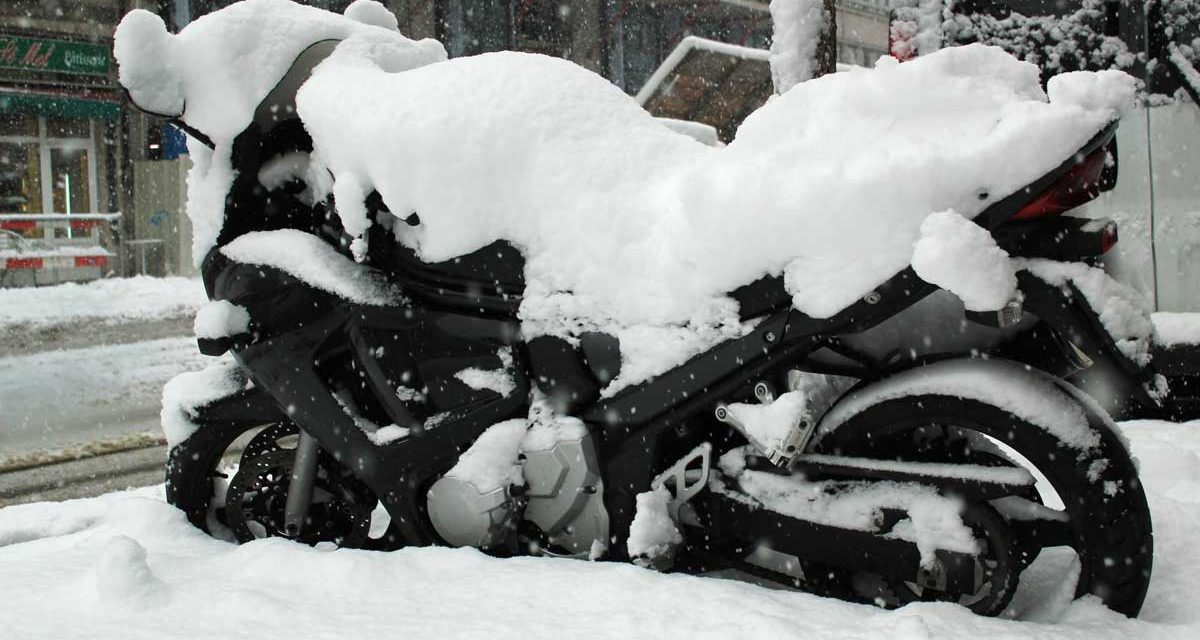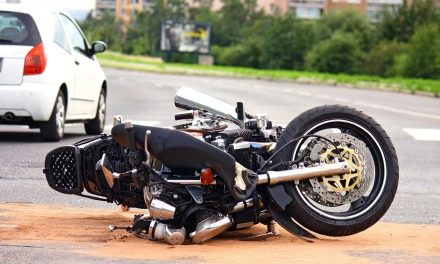With another winter quickly approaching, motorcycle owners everywhere should be beginning the process of winterizing their rides. But if you’re a new owner, you might not yet be familiar with how to properly carry out this task.
By the end of this article, you’ll have all the information required to make sure your motorcycle is winterized properly and ready to roar when next spring comes around!
What happens if you don’t winterize your motorcycle?
Before we get into the details of how to winterize your motorcycle, first it’s important to understand WHY you need to winterize your motorcycle. Why can’t you just put it in storage and fire it up next year as soon as the snow is gone?
There are a number of reasons why it’s important to winterize your motorcycle each year. Doing so helps to protect against:
- Moisture damage – You may be thinking, “I’ve ridden my motorcycle in the rain before and nothing bad happened, so why do I need to worry about moisture damage?” While your bike is designed to withstand rainy conditions every once in a while, the prolonged exposure to such elements that can cause unwanted damage to your motorcycle.
That’s why it’s recommended that you store your bike somewhere that protects it against the harsh elements of our Canadian climate.
- Corrosion/rust – If you’ve ever taken the cover off your motorcycle after a winter in storage only to find rust spots developing on its shiny chrome surfaces, you’ll know this feeling – your stomach drops and you immediately begin panicking, trying to find a way to fix the problem. Unfortunately, sometimes these blemishes are irreversible.
But what if you could prevent it from happening in the first place?
Proper winterization can prevent things like excess moisture or dead bugs causing rust or corroding the paint on your motorcycle.
- Battery drainage – You need your battery to be functioning at a high level if you want your motorcycle to start up in the spring. Cold temperatures slow down or completely stop the chemical reactions required for batteries to do their job.
That’s why it’s so important to properly winterize your battery after your last ride of the year.
- Fuel pump and tank issues – When your gas tank isn’t put to use (such as during the winter months), it has a higher likelihood of developing rust. Also, the gas in your motorcycle begins to become thick and gummy after a certain period of time.
Proper winterization techniques – such as adding a fuel-stabilizer – can prevent these things from occurring.
- Flat spots on tires – The weight of your bike causes the tires to change shape and flatten to match the contour of the ground it’s resting on. If you store your bike outside, this can become a problem because the rubber will freeze and likely still hold this warped shape come springtime.
These are just a few of the reasons why you NEED to be winterizing your motorcycle each year.
Now, let’s take a look at a few questions that riders often have about the winterization process!
Should you cover your motorcycle?
If you’re looking to make sure your motorcycle is in A1 condition come next riding season, investing in the proper cover for your bike is a good idea, especially if you plan on storing it outdoors.
Elements like rain, wind, sleet, snow and yes, even sun, can take a toll on the condition of your motorcycle. Without the proper cover, you put your bike at risk for rust, electrical problems, corrosion, and more frustrating issues.
Even if you store your bike indoors, covers can help prevent dust and debris from finding their way into important components of your motorcycle.
Here are a few things to look for when deciding on the proper cover for your motorcycle:
- Intended use – are you storing your motorcycle inside or outside? Depending on your answer, the type of cover you require will vary. Outdoor covers incorporate a waterproof design and are specifically manufactured to protect against the elements.
- Size – It’s important that the cover you select for your motorcycle is a snug fit. This way, no dust or moisture will be able to get underneath/around your cover and you can be sure your bike will be protected.
- Material – Lightweight? Heavy-duty? Water-proof? Water-resistant? Non-waterproof? When it comes to selecting the material for your motorcycle’s cover, be sure to consider the type of material that best suits your storage location.
Can I leave my motorcycle outside in the winter?
Outdoor storage exposes your motorcycle to harmful elements, inconsistent moisture levels, and the prying eyes of thieves, so it’s best to avoid outdoor-storage at all costs. Ideally, a heated or protected garage is the best place to store your bike.
However, I understand that many people do not have the space required to do this, so here are your next best options:
Shed: If there’s no room in your garage, a shed is your next best bet. Storing your bike in a shed provides protection from wind, rain, and snow.
Inside your motorhome: If you don’t have a shed and your garage is full, consider storing your motorcycle inside your motorhome or camper. Although this method is unconventional to say the least (and may take some planning), your camper or motorhome can provide adequate protection to keep your bike safe.
Underneath the deck: If you have extra space under your deck, consider storing your bike here for the winter. Although not ideal, this location will provide a higher level of protection from the elements than simply keeping it out in the open.
Backyard: If you don’t have a deck or have a shortage of space underneath it, store your motorcycle in your backyard. Try to keep it against the back wall of your house to at least provide some protection from the elements.
Front yard: If the front yard is your only option for storing your motorcycle, make sure it is covered and kept close to the building. If you can chain it to a railing or solid structure to prevent theft, even better!
Regardless of which option you select, a quality cover is a necessity for outdoor storage.
Inside vs. Outside Storage
Obviously, inside storage is the ideal option for storing your motorcycle over the winter. It provides a temperature-controlled environment while keeping your bike away from rain, snow, hail, and wind.
However, with the proper cover and some strategic planning, there are ways to safely store your motorcycle outdoors for the winter.
But when storing your motorcycle outside, be careful – if your ride is constantly “on display,” those with the wrong intentions may take it as an open invitation to engage in criminal acts like theft or vandalism.
How do I keep my motorcycle battery charged in the winter?
Spring has finally arrived, the snow is gone, and you’re ready to ride. This time of year is like Christmas morning for bike enthusiasts everywhere. You take a seat on your motorcycle, just seconds away from hearing the sound you’ve been dreaming about all winter. You turn the key, almost salivating over the low, thunderous roar that’s about to fill your ears. Instead, all you get is… click.click.click. Your battery is dead.
Batteries are a critical component of the starter motor, ignition system, lights, and many other important parts of your motorcycle’s operation system. So how do you keep them charged over the long, cold winter months?
You have a couple of options here:
You can choose to completely remove your battery from your bike, clean it with sandpaper or a wire brush, and trickle charge it at regular intervals throughout the winter.
OR
If your winters are on the mild side, make sure your battery is fully charged before putting your motorcycle in storage and periodically top-off the charge every 4 weeks.
If your winters involve consistent low temperatures, the first option is probably your best bet because it’s the most effective for preventing battery drain or damage resulting from the cold weather.
Should I start my motorcycle in the winter?
I completely understand – it’s mid-January, you have the winter blues, and you just want to open up the throttle and hear her purr for five minutes. But is there a benefit to letting your motorcycle run intermittently throughout the winter? Or could it actually be harmful?
Whether or not you should start your motorcycle during the winter depends on if you actually intend to take it out for a spin. If you plan on just letting it idle, you may actually be damaging your bike. That’s because idling doesn’t get your engine up to full temperature, but just warm enough to create condensation. This condensation can later act as the catalyst for the development of rust.
If however, roads permitting, you can actually take your motorcycle out, then go for a ride! As long as your engine gets up to full temperature, you’re doing no harm and even topping off the charge on your battery!
How cold is too cold for a motorcycle?
This question hinges largely on the personal preferences of each rider. However, regardless of how confident you feel on your bike in cold weather, here are some factors you must consider:
- Conditions – As we all know, road conditions worsen with the dropping temperatures. Ice, snow, and freezing rain resulting from sub-zero temperatures can have a major effect on traction and visibility.
- Equipment – Cold temperatures increase the risk of hypothermia. Without the proper clothing, it’s unsafe to ride your motorcycle in cold weather. Also, as the thermometer approaches 0 degrees, your visor has a greater risk of fogging resulting in decreased visibility.
- Your bike’s performance – As the temperature drops, tire pressure decreases along with it. Also, cold temperatures drain battery life, so you may have difficulty even starting your bike.
So, here’s a good rule of thumb for taking your motorcycle out in cold weather – As long as you’re adequately dressed, it’s safe to ride until about 0 degrees Celsius. After that, road conditions are more likely to degrade and equipment has a greater chance of malfunctioning meaning you’ll be riding at your own risk!





